Investigating the Correlation Between House Prices and Immigration
VerifiedAdded on 2020/02/24
|20
|3752
|42
Report
AI Summary
This report presents a detailed literature review exploring the correlation between house prices and immigration rates across different countries and time periods. It investigates the direct relationship between housing prices and immigration, examining factors influencing both. The report analyzes changes in demand and supply from 2000 to 2017, considering economic scenarios and the impact of migration on housing markets. It discusses how immigration affects house prices and vice-versa. The study provides an overview of the conceptual framework, and reviews the relationship between house prices and immigration rates in different countries like UK, New Zealand, Australia, US, Germany, and Greece. The report also explores the changes in the relationship over time, focusing on the periods between 2000-2010 and 2011-2017, and identifies literature gaps. The report concludes by summarizing the key findings and implications of the research.
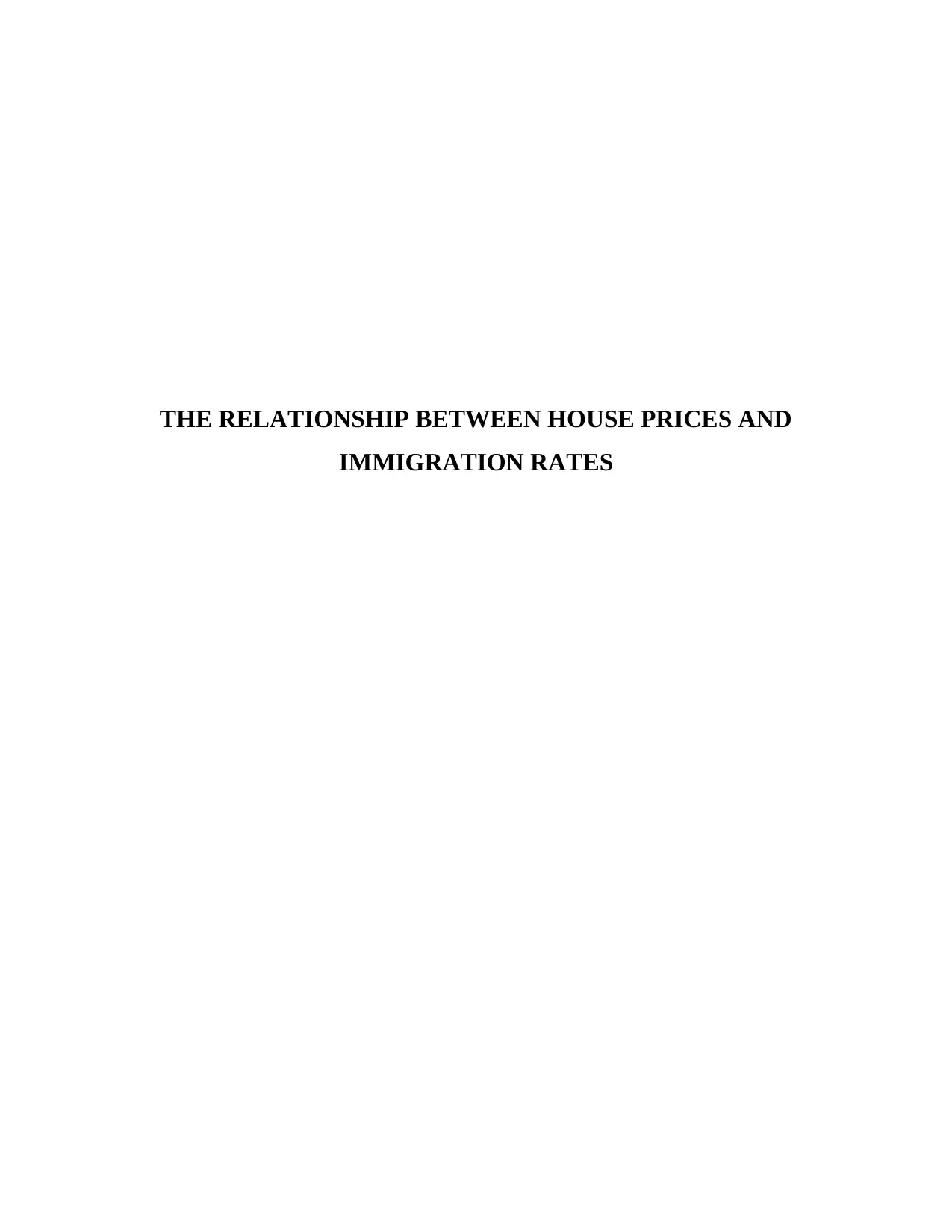
THE RELATIONSHIP BETWEEN HOUSE PRICES AND
IMMIGRATION RATES
IMMIGRATION RATES
Paraphrase This Document
Need a fresh take? Get an instant paraphrase of this document with our AI Paraphraser
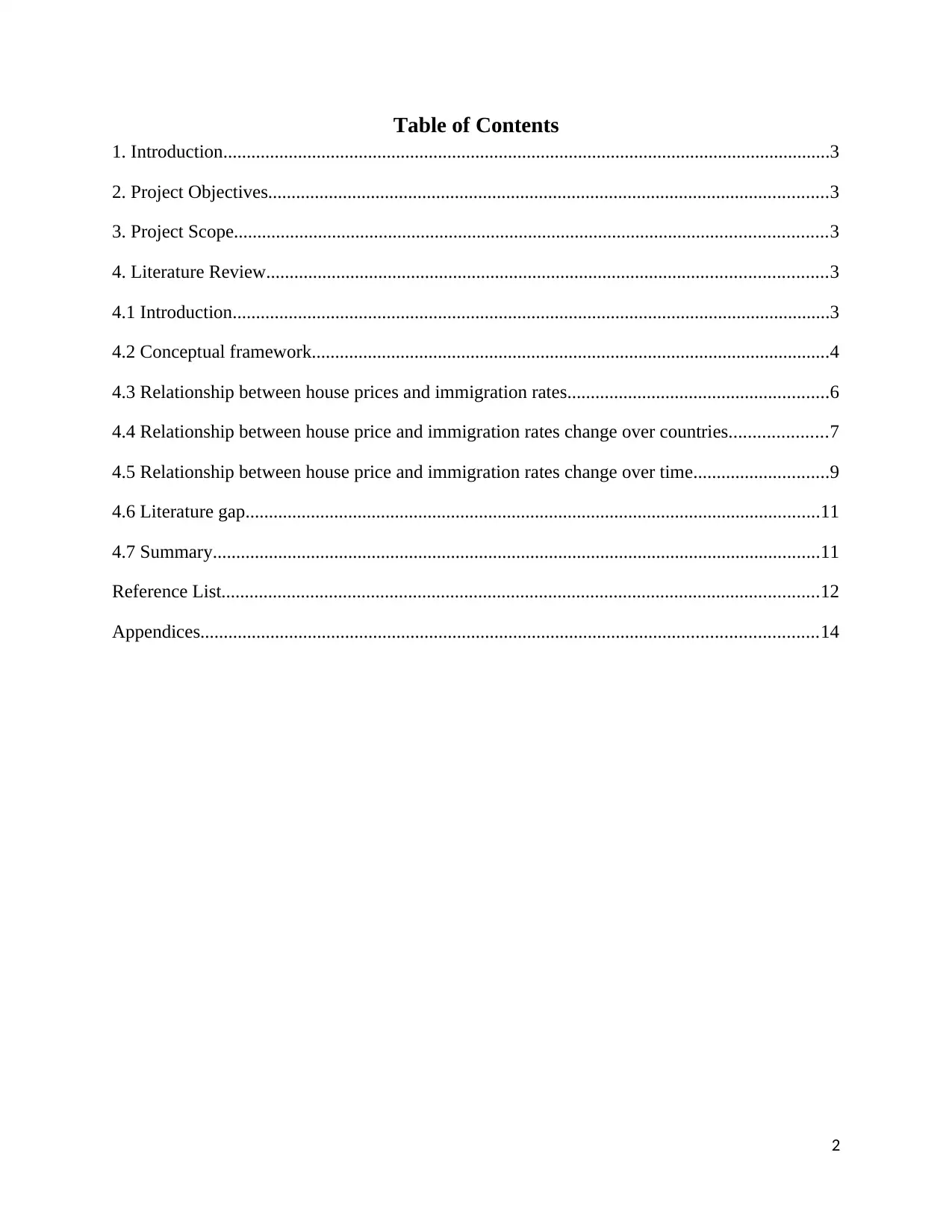
Table of Contents
1. Introduction..................................................................................................................................3
2. Project Objectives........................................................................................................................3
3. Project Scope...............................................................................................................................3
4. Literature Review........................................................................................................................3
4.1 Introduction................................................................................................................................3
4.2 Conceptual framework...............................................................................................................4
4.3 Relationship between house prices and immigration rates........................................................6
4.4 Relationship between house price and immigration rates change over countries.....................7
4.5 Relationship between house price and immigration rates change over time.............................9
4.6 Literature gap...........................................................................................................................11
4.7 Summary..................................................................................................................................11
Reference List................................................................................................................................12
Appendices....................................................................................................................................14
2
1. Introduction..................................................................................................................................3
2. Project Objectives........................................................................................................................3
3. Project Scope...............................................................................................................................3
4. Literature Review........................................................................................................................3
4.1 Introduction................................................................................................................................3
4.2 Conceptual framework...............................................................................................................4
4.3 Relationship between house prices and immigration rates........................................................6
4.4 Relationship between house price and immigration rates change over countries.....................7
4.5 Relationship between house price and immigration rates change over time.............................9
4.6 Literature gap...........................................................................................................................11
4.7 Summary..................................................................................................................................11
Reference List................................................................................................................................12
Appendices....................................................................................................................................14
2
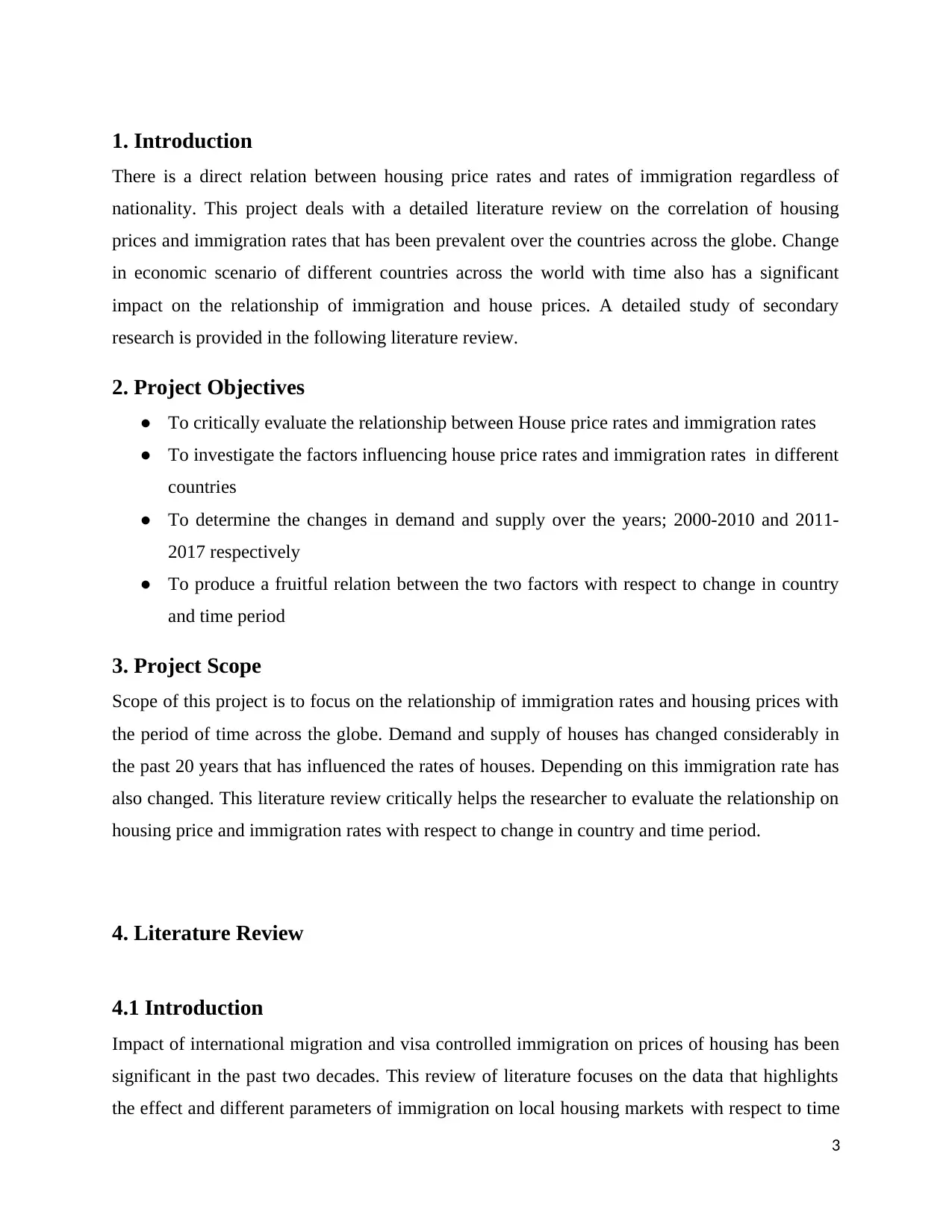
1. Introduction
There is a direct relation between housing price rates and rates of immigration regardless of
nationality. This project deals with a detailed literature review on the correlation of housing
prices and immigration rates that has been prevalent over the countries across the globe. Change
in economic scenario of different countries across the world with time also has a significant
impact on the relationship of immigration and house prices. A detailed study of secondary
research is provided in the following literature review.
2. Project Objectives
● To critically evaluate the relationship between House price rates and immigration rates
● To investigate the factors influencing house price rates and immigration rates in different
countries
● To determine the changes in demand and supply over the years; 2000-2010 and 2011-
2017 respectively
● To produce a fruitful relation between the two factors with respect to change in country
and time period
3. Project Scope
Scope of this project is to focus on the relationship of immigration rates and housing prices with
the period of time across the globe. Demand and supply of houses has changed considerably in
the past 20 years that has influenced the rates of houses. Depending on this immigration rate has
also changed. This literature review critically helps the researcher to evaluate the relationship on
housing price and immigration rates with respect to change in country and time period.
4. Literature Review
4.1 Introduction
Impact of international migration and visa controlled immigration on prices of housing has been
significant in the past two decades. This review of literature focuses on the data that highlights
the effect and different parameters of immigration on local housing markets with respect to time
3
There is a direct relation between housing price rates and rates of immigration regardless of
nationality. This project deals with a detailed literature review on the correlation of housing
prices and immigration rates that has been prevalent over the countries across the globe. Change
in economic scenario of different countries across the world with time also has a significant
impact on the relationship of immigration and house prices. A detailed study of secondary
research is provided in the following literature review.
2. Project Objectives
● To critically evaluate the relationship between House price rates and immigration rates
● To investigate the factors influencing house price rates and immigration rates in different
countries
● To determine the changes in demand and supply over the years; 2000-2010 and 2011-
2017 respectively
● To produce a fruitful relation between the two factors with respect to change in country
and time period
3. Project Scope
Scope of this project is to focus on the relationship of immigration rates and housing prices with
the period of time across the globe. Demand and supply of houses has changed considerably in
the past 20 years that has influenced the rates of houses. Depending on this immigration rate has
also changed. This literature review critically helps the researcher to evaluate the relationship on
housing price and immigration rates with respect to change in country and time period.
4. Literature Review
4.1 Introduction
Impact of international migration and visa controlled immigration on prices of housing has been
significant in the past two decades. This review of literature focuses on the data that highlights
the effect and different parameters of immigration on local housing markets with respect to time
3
⊘ This is a preview!⊘
Do you want full access?
Subscribe today to unlock all pages.

Trusted by 1+ million students worldwide
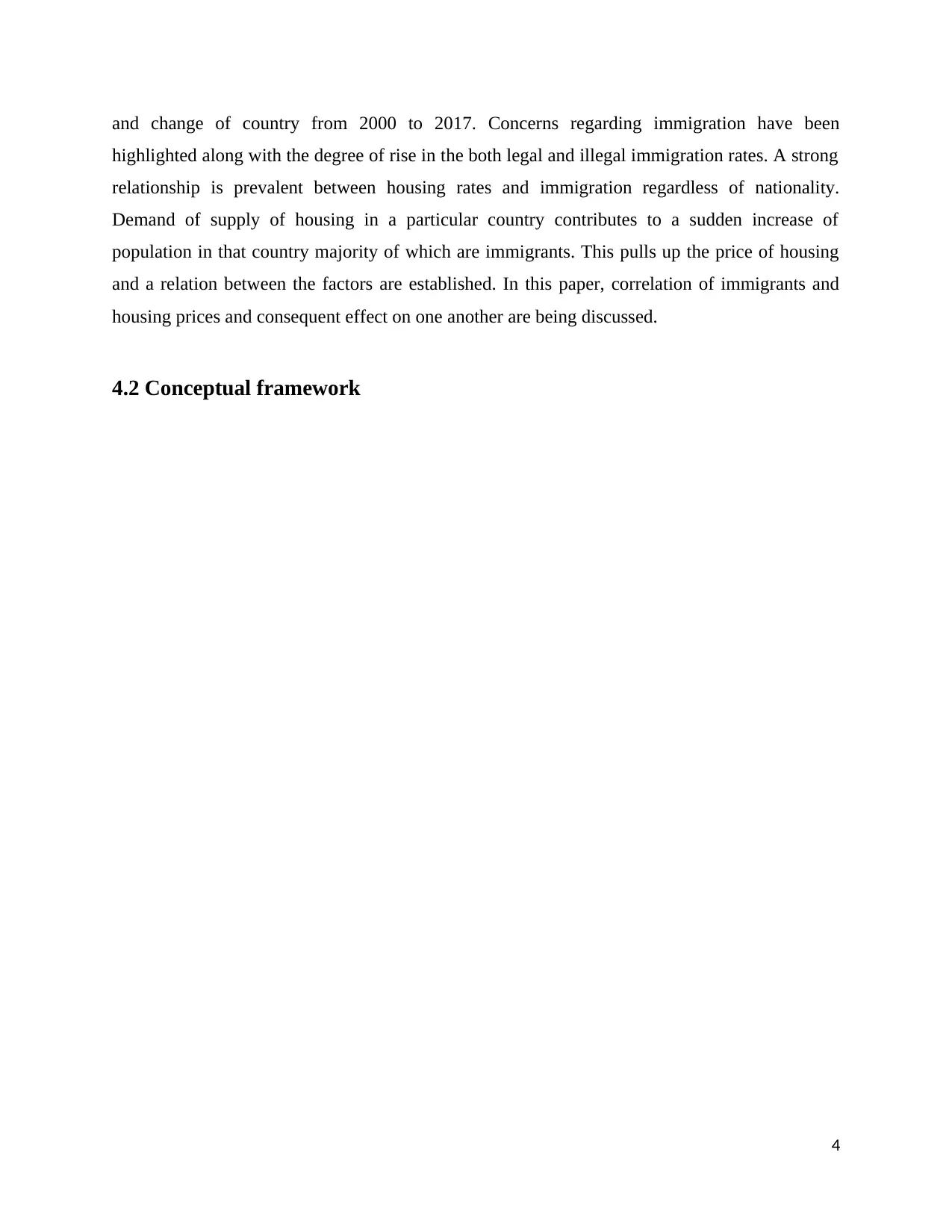
and change of country from 2000 to 2017. Concerns regarding immigration have been
highlighted along with the degree of rise in the both legal and illegal immigration rates. A strong
relationship is prevalent between housing rates and immigration regardless of nationality.
Demand of supply of housing in a particular country contributes to a sudden increase of
population in that country majority of which are immigrants. This pulls up the price of housing
and a relation between the factors are established. In this paper, correlation of immigrants and
housing prices and consequent effect on one another are being discussed.
4.2 Conceptual framework
4
highlighted along with the degree of rise in the both legal and illegal immigration rates. A strong
relationship is prevalent between housing rates and immigration regardless of nationality.
Demand of supply of housing in a particular country contributes to a sudden increase of
population in that country majority of which are immigrants. This pulls up the price of housing
and a relation between the factors are established. In this paper, correlation of immigrants and
housing prices and consequent effect on one another are being discussed.
4.2 Conceptual framework
4
Paraphrase This Document
Need a fresh take? Get an instant paraphrase of this document with our AI Paraphraser
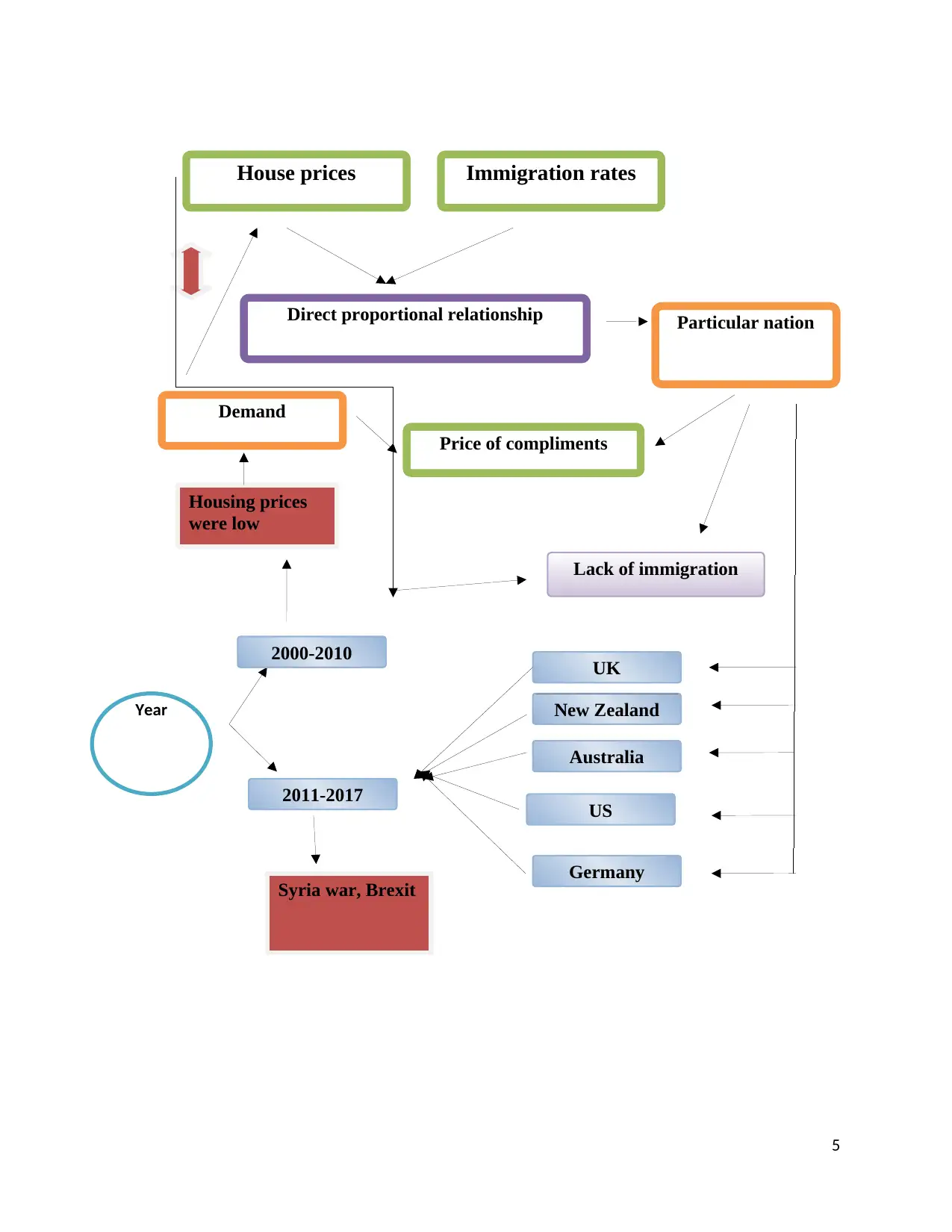
House prices Immigration rates
Direct proportional relationship Particular nation
Demand
Price of compliments
Lack of immigration
UK
New Zealand
Australia
US
Germany
Year
2000-2010
2011-2017
Housing prices
were low
Syria war, Brexit
5
Direct proportional relationship Particular nation
Demand
Price of compliments
Lack of immigration
UK
New Zealand
Australia
US
Germany
Year
2000-2010
2011-2017
Housing prices
were low
Syria war, Brexit
5
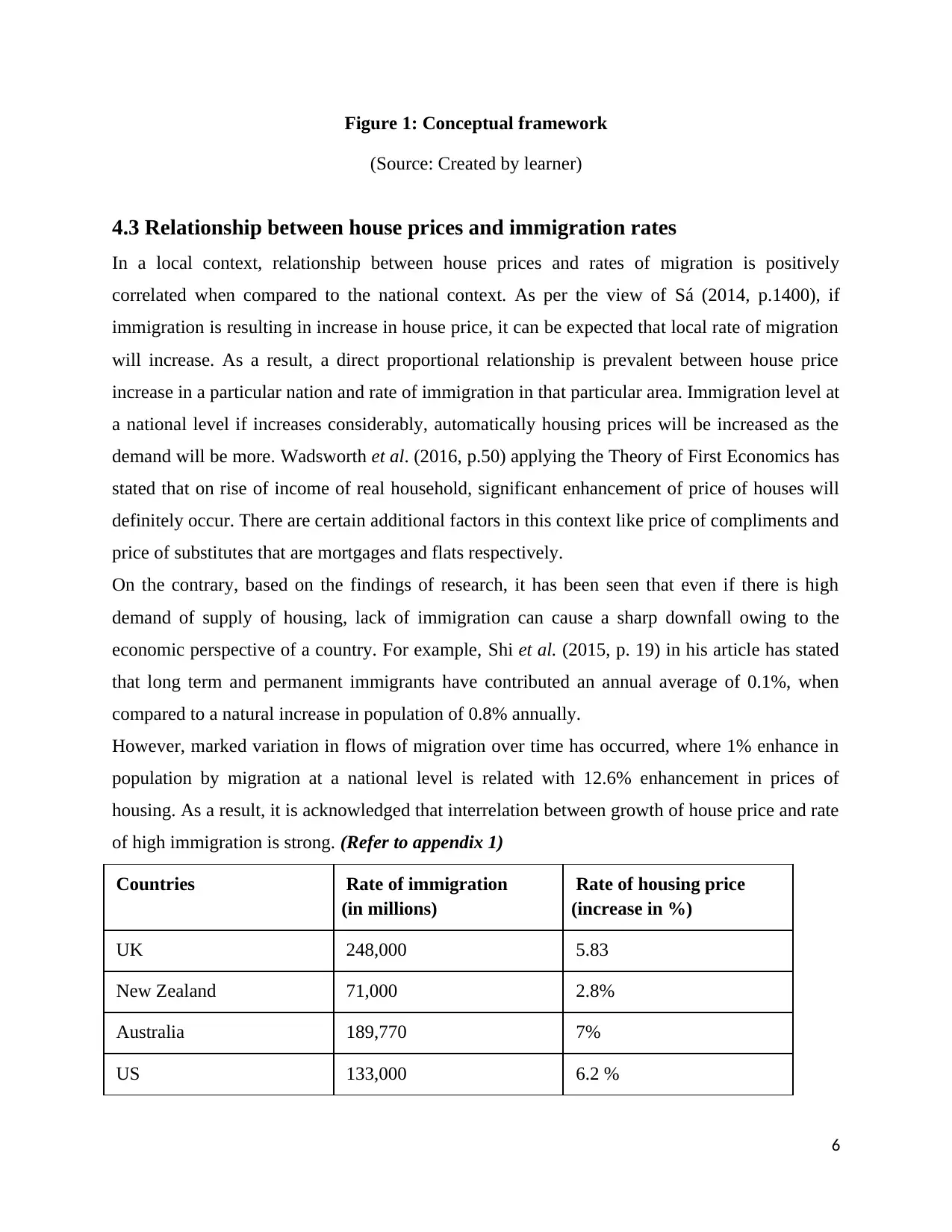
Figure 1: Conceptual framework
(Source: Created by learner)
4.3 Relationship between house prices and immigration rates
In a local context, relationship between house prices and rates of migration is positively
correlated when compared to the national context. As per the view of Sá (2014, p.1400), if
immigration is resulting in increase in house price, it can be expected that local rate of migration
will increase. As a result, a direct proportional relationship is prevalent between house price
increase in a particular nation and rate of immigration in that particular area. Immigration level at
a national level if increases considerably, automatically housing prices will be increased as the
demand will be more. Wadsworth et al. (2016, p.50) applying the Theory of First Economics has
stated that on rise of income of real household, significant enhancement of price of houses will
definitely occur. There are certain additional factors in this context like price of compliments and
price of substitutes that are mortgages and flats respectively.
On the contrary, based on the findings of research, it has been seen that even if there is high
demand of supply of housing, lack of immigration can cause a sharp downfall owing to the
economic perspective of a country. For example, Shi et al. (2015, p. 19) in his article has stated
that long term and permanent immigrants have contributed an annual average of 0.1%, when
compared to a natural increase in population of 0.8% annually.
However, marked variation in flows of migration over time has occurred, where 1% enhance in
population by migration at a national level is related with 12.6% enhancement in prices of
housing. As a result, it is acknowledged that interrelation between growth of house price and rate
of high immigration is strong. (Refer to appendix 1)
Countries Rate of immigration
(in millions)
Rate of housing price
(increase in %)
UK 248,000 5.83
New Zealand 71,000 2.8%
Australia 189,770 7%
US 133,000 6.2 %
6
(Source: Created by learner)
4.3 Relationship between house prices and immigration rates
In a local context, relationship between house prices and rates of migration is positively
correlated when compared to the national context. As per the view of Sá (2014, p.1400), if
immigration is resulting in increase in house price, it can be expected that local rate of migration
will increase. As a result, a direct proportional relationship is prevalent between house price
increase in a particular nation and rate of immigration in that particular area. Immigration level at
a national level if increases considerably, automatically housing prices will be increased as the
demand will be more. Wadsworth et al. (2016, p.50) applying the Theory of First Economics has
stated that on rise of income of real household, significant enhancement of price of houses will
definitely occur. There are certain additional factors in this context like price of compliments and
price of substitutes that are mortgages and flats respectively.
On the contrary, based on the findings of research, it has been seen that even if there is high
demand of supply of housing, lack of immigration can cause a sharp downfall owing to the
economic perspective of a country. For example, Shi et al. (2015, p. 19) in his article has stated
that long term and permanent immigrants have contributed an annual average of 0.1%, when
compared to a natural increase in population of 0.8% annually.
However, marked variation in flows of migration over time has occurred, where 1% enhance in
population by migration at a national level is related with 12.6% enhancement in prices of
housing. As a result, it is acknowledged that interrelation between growth of house price and rate
of high immigration is strong. (Refer to appendix 1)
Countries Rate of immigration
(in millions)
Rate of housing price
(increase in %)
UK 248,000 5.83
New Zealand 71,000 2.8%
Australia 189,770 7%
US 133,000 6.2 %
6
⊘ This is a preview!⊘
Do you want full access?
Subscribe today to unlock all pages.

Trusted by 1+ million students worldwide
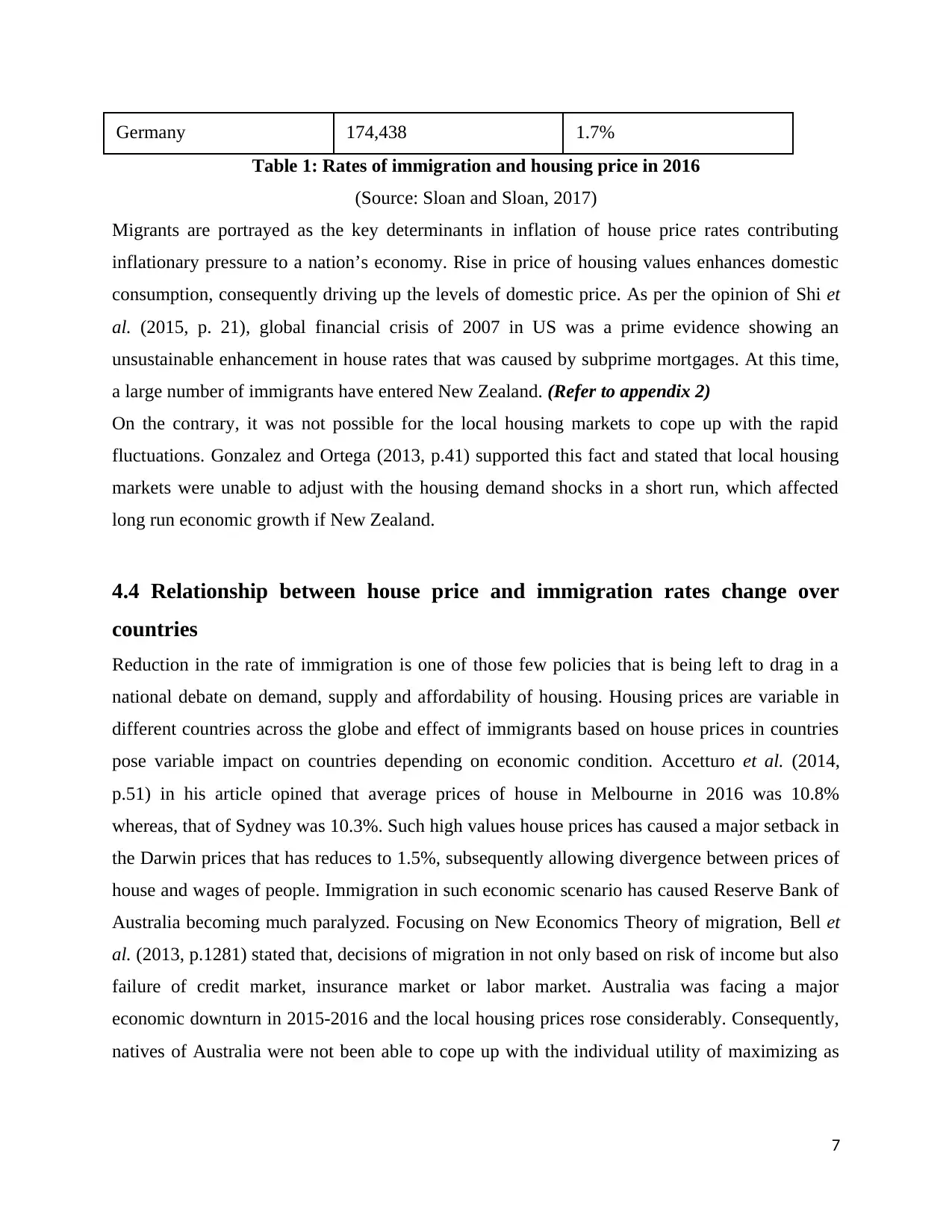
Germany 174,438 1.7%
Table 1: Rates of immigration and housing price in 2016
(Source: Sloan and Sloan, 2017)
Migrants are portrayed as the key determinants in inflation of house price rates contributing
inflationary pressure to a nation’s economy. Rise in price of housing values enhances domestic
consumption, consequently driving up the levels of domestic price. As per the opinion of Shi et
al. (2015, p. 21), global financial crisis of 2007 in US was a prime evidence showing an
unsustainable enhancement in house rates that was caused by subprime mortgages. At this time,
a large number of immigrants have entered New Zealand. (Refer to appendix 2)
On the contrary, it was not possible for the local housing markets to cope up with the rapid
fluctuations. Gonzalez and Ortega (2013, p.41) supported this fact and stated that local housing
markets were unable to adjust with the housing demand shocks in a short run, which affected
long run economic growth if New Zealand.
4.4 Relationship between house price and immigration rates change over
countries
Reduction in the rate of immigration is one of those few policies that is being left to drag in a
national debate on demand, supply and affordability of housing. Housing prices are variable in
different countries across the globe and effect of immigrants based on house prices in countries
pose variable impact on countries depending on economic condition. Accetturo et al. (2014,
p.51) in his article opined that average prices of house in Melbourne in 2016 was 10.8%
whereas, that of Sydney was 10.3%. Such high values house prices has caused a major setback in
the Darwin prices that has reduces to 1.5%, subsequently allowing divergence between prices of
house and wages of people. Immigration in such economic scenario has caused Reserve Bank of
Australia becoming much paralyzed. Focusing on New Economics Theory of migration, Bell et
al. (2013, p.1281) stated that, decisions of migration in not only based on risk of income but also
failure of credit market, insurance market or labor market. Australia was facing a major
economic downturn in 2015-2016 and the local housing prices rose considerably. Consequently,
natives of Australia were not been able to cope up with the individual utility of maximizing as
7
Table 1: Rates of immigration and housing price in 2016
(Source: Sloan and Sloan, 2017)
Migrants are portrayed as the key determinants in inflation of house price rates contributing
inflationary pressure to a nation’s economy. Rise in price of housing values enhances domestic
consumption, consequently driving up the levels of domestic price. As per the opinion of Shi et
al. (2015, p. 21), global financial crisis of 2007 in US was a prime evidence showing an
unsustainable enhancement in house rates that was caused by subprime mortgages. At this time,
a large number of immigrants have entered New Zealand. (Refer to appendix 2)
On the contrary, it was not possible for the local housing markets to cope up with the rapid
fluctuations. Gonzalez and Ortega (2013, p.41) supported this fact and stated that local housing
markets were unable to adjust with the housing demand shocks in a short run, which affected
long run economic growth if New Zealand.
4.4 Relationship between house price and immigration rates change over
countries
Reduction in the rate of immigration is one of those few policies that is being left to drag in a
national debate on demand, supply and affordability of housing. Housing prices are variable in
different countries across the globe and effect of immigrants based on house prices in countries
pose variable impact on countries depending on economic condition. Accetturo et al. (2014,
p.51) in his article opined that average prices of house in Melbourne in 2016 was 10.8%
whereas, that of Sydney was 10.3%. Such high values house prices has caused a major setback in
the Darwin prices that has reduces to 1.5%, subsequently allowing divergence between prices of
house and wages of people. Immigration in such economic scenario has caused Reserve Bank of
Australia becoming much paralyzed. Focusing on New Economics Theory of migration, Bell et
al. (2013, p.1281) stated that, decisions of migration in not only based on risk of income but also
failure of credit market, insurance market or labor market. Australia was facing a major
economic downturn in 2015-2016 and the local housing prices rose considerably. Consequently,
natives of Australia were not been able to cope up with the individual utility of maximizing as
7
Paraphrase This Document
Need a fresh take? Get an instant paraphrase of this document with our AI Paraphraser
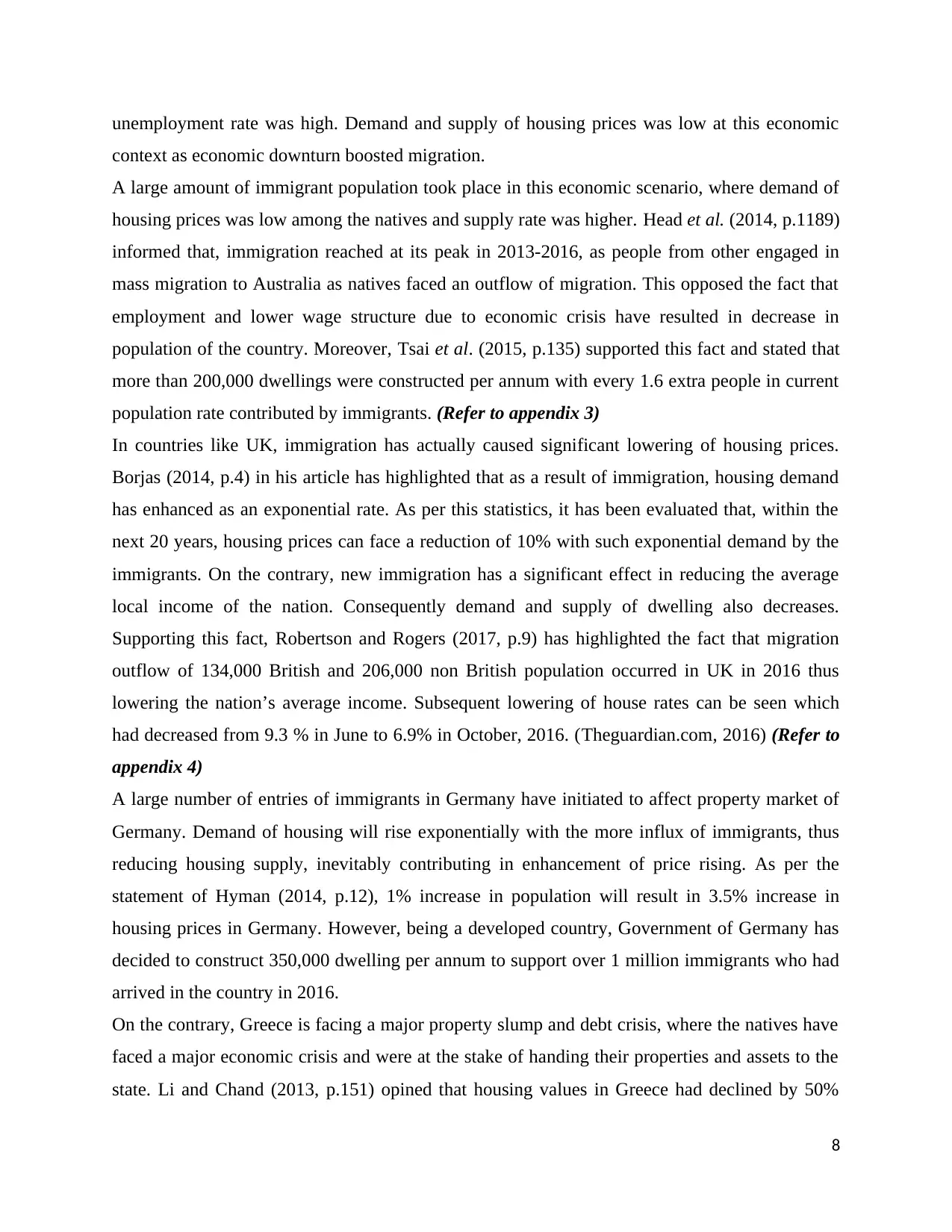
unemployment rate was high. Demand and supply of housing prices was low at this economic
context as economic downturn boosted migration.
A large amount of immigrant population took place in this economic scenario, where demand of
housing prices was low among the natives and supply rate was higher. Head et al. (2014, p.1189)
informed that, immigration reached at its peak in 2013-2016, as people from other engaged in
mass migration to Australia as natives faced an outflow of migration. This opposed the fact that
employment and lower wage structure due to economic crisis have resulted in decrease in
population of the country. Moreover, Tsai et al. (2015, p.135) supported this fact and stated that
more than 200,000 dwellings were constructed per annum with every 1.6 extra people in current
population rate contributed by immigrants. (Refer to appendix 3)
In countries like UK, immigration has actually caused significant lowering of housing prices.
Borjas (2014, p.4) in his article has highlighted that as a result of immigration, housing demand
has enhanced as an exponential rate. As per this statistics, it has been evaluated that, within the
next 20 years, housing prices can face a reduction of 10% with such exponential demand by the
immigrants. On the contrary, new immigration has a significant effect in reducing the average
local income of the nation. Consequently demand and supply of dwelling also decreases.
Supporting this fact, Robertson and Rogers (2017, p.9) has highlighted the fact that migration
outflow of 134,000 British and 206,000 non British population occurred in UK in 2016 thus
lowering the nation’s average income. Subsequent lowering of house rates can be seen which
had decreased from 9.3 % in June to 6.9% in October, 2016. (Theguardian.com, 2016) (Refer to
appendix 4)
A large number of entries of immigrants in Germany have initiated to affect property market of
Germany. Demand of housing will rise exponentially with the more influx of immigrants, thus
reducing housing supply, inevitably contributing in enhancement of price rising. As per the
statement of Hyman (2014, p.12), 1% increase in population will result in 3.5% increase in
housing prices in Germany. However, being a developed country, Government of Germany has
decided to construct 350,000 dwelling per annum to support over 1 million immigrants who had
arrived in the country in 2016.
On the contrary, Greece is facing a major property slump and debt crisis, where the natives have
faced a major economic crisis and were at the stake of handing their properties and assets to the
state. Li and Chand (2013, p.151) opined that housing values in Greece had declined by 50%
8
context as economic downturn boosted migration.
A large amount of immigrant population took place in this economic scenario, where demand of
housing prices was low among the natives and supply rate was higher. Head et al. (2014, p.1189)
informed that, immigration reached at its peak in 2013-2016, as people from other engaged in
mass migration to Australia as natives faced an outflow of migration. This opposed the fact that
employment and lower wage structure due to economic crisis have resulted in decrease in
population of the country. Moreover, Tsai et al. (2015, p.135) supported this fact and stated that
more than 200,000 dwellings were constructed per annum with every 1.6 extra people in current
population rate contributed by immigrants. (Refer to appendix 3)
In countries like UK, immigration has actually caused significant lowering of housing prices.
Borjas (2014, p.4) in his article has highlighted that as a result of immigration, housing demand
has enhanced as an exponential rate. As per this statistics, it has been evaluated that, within the
next 20 years, housing prices can face a reduction of 10% with such exponential demand by the
immigrants. On the contrary, new immigration has a significant effect in reducing the average
local income of the nation. Consequently demand and supply of dwelling also decreases.
Supporting this fact, Robertson and Rogers (2017, p.9) has highlighted the fact that migration
outflow of 134,000 British and 206,000 non British population occurred in UK in 2016 thus
lowering the nation’s average income. Subsequent lowering of house rates can be seen which
had decreased from 9.3 % in June to 6.9% in October, 2016. (Theguardian.com, 2016) (Refer to
appendix 4)
A large number of entries of immigrants in Germany have initiated to affect property market of
Germany. Demand of housing will rise exponentially with the more influx of immigrants, thus
reducing housing supply, inevitably contributing in enhancement of price rising. As per the
statement of Hyman (2014, p.12), 1% increase in population will result in 3.5% increase in
housing prices in Germany. However, being a developed country, Government of Germany has
decided to construct 350,000 dwelling per annum to support over 1 million immigrants who had
arrived in the country in 2016.
On the contrary, Greece is facing a major property slump and debt crisis, where the natives have
faced a major economic crisis and were at the stake of handing their properties and assets to the
state. Li and Chand (2013, p.151) opined that housing values in Greece had declined by 50%
8
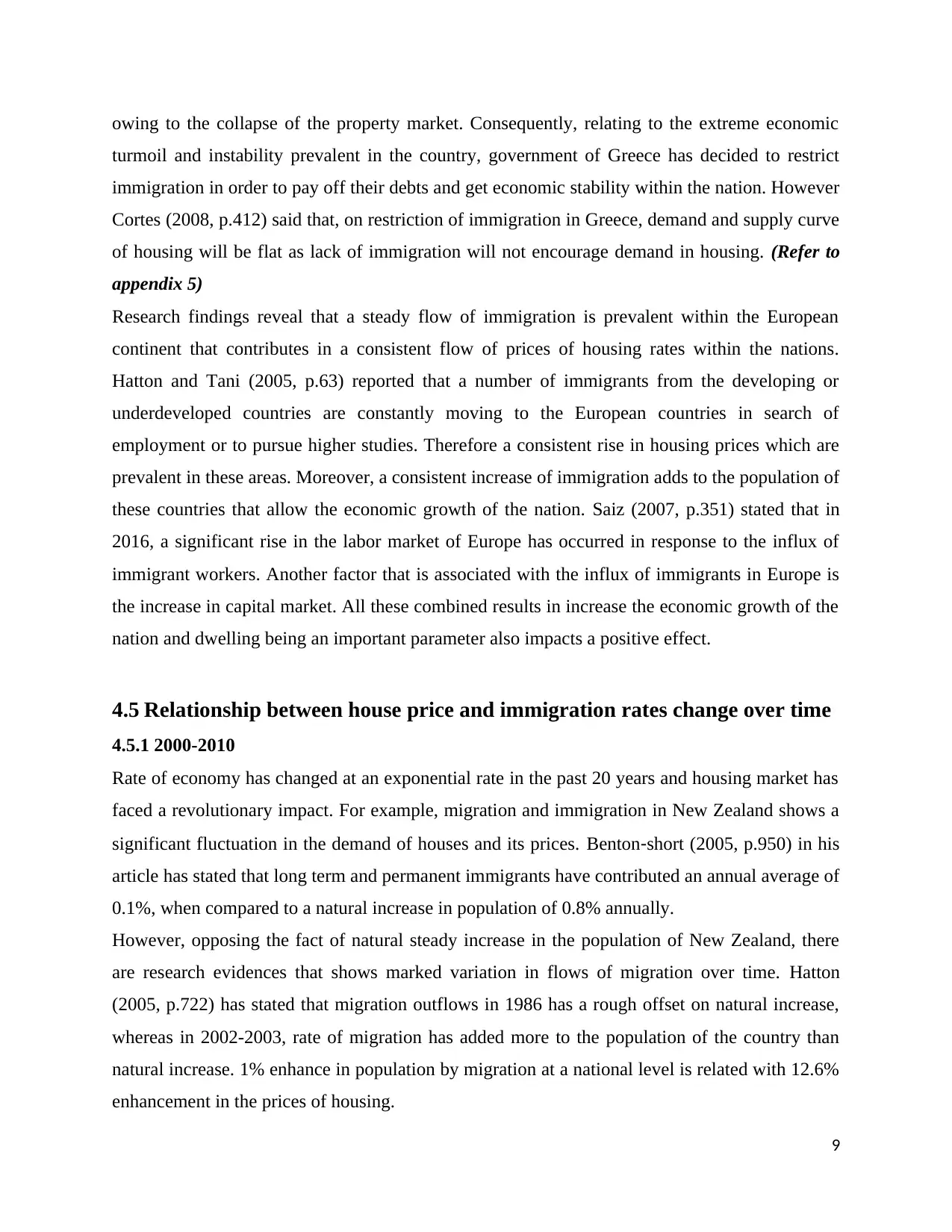
owing to the collapse of the property market. Consequently, relating to the extreme economic
turmoil and instability prevalent in the country, government of Greece has decided to restrict
immigration in order to pay off their debts and get economic stability within the nation. However
Cortes (2008, p.412) said that, on restriction of immigration in Greece, demand and supply curve
of housing will be flat as lack of immigration will not encourage demand in housing. (Refer to
appendix 5)
Research findings reveal that a steady flow of immigration is prevalent within the European
continent that contributes in a consistent flow of prices of housing rates within the nations.
Hatton and Tani (2005, p.63) reported that a number of immigrants from the developing or
underdeveloped countries are constantly moving to the European countries in search of
employment or to pursue higher studies. Therefore a consistent rise in housing prices which are
prevalent in these areas. Moreover, a consistent increase of immigration adds to the population of
these countries that allow the economic growth of the nation. Saiz (2007, p.351) stated that in
2016, a significant rise in the labor market of Europe has occurred in response to the influx of
immigrant workers. Another factor that is associated with the influx of immigrants in Europe is
the increase in capital market. All these combined results in increase the economic growth of the
nation and dwelling being an important parameter also impacts a positive effect.
4.5 Relationship between house price and immigration rates change over time
4.5.1 2000-2010
Rate of economy has changed at an exponential rate in the past 20 years and housing market has
faced a revolutionary impact. For example, migration and immigration in New Zealand shows a
significant fluctuation in the demand of houses and its prices. Benton‐short (2005, p.950) in his
article has stated that long term and permanent immigrants have contributed an annual average of
0.1%, when compared to a natural increase in population of 0.8% annually.
However, opposing the fact of natural steady increase in the population of New Zealand, there
are research evidences that shows marked variation in flows of migration over time. Hatton
(2005, p.722) has stated that migration outflows in 1986 has a rough offset on natural increase,
whereas in 2002-2003, rate of migration has added more to the population of the country than
natural increase. 1% enhance in population by migration at a national level is related with 12.6%
enhancement in the prices of housing.
9
turmoil and instability prevalent in the country, government of Greece has decided to restrict
immigration in order to pay off their debts and get economic stability within the nation. However
Cortes (2008, p.412) said that, on restriction of immigration in Greece, demand and supply curve
of housing will be flat as lack of immigration will not encourage demand in housing. (Refer to
appendix 5)
Research findings reveal that a steady flow of immigration is prevalent within the European
continent that contributes in a consistent flow of prices of housing rates within the nations.
Hatton and Tani (2005, p.63) reported that a number of immigrants from the developing or
underdeveloped countries are constantly moving to the European countries in search of
employment or to pursue higher studies. Therefore a consistent rise in housing prices which are
prevalent in these areas. Moreover, a consistent increase of immigration adds to the population of
these countries that allow the economic growth of the nation. Saiz (2007, p.351) stated that in
2016, a significant rise in the labor market of Europe has occurred in response to the influx of
immigrant workers. Another factor that is associated with the influx of immigrants in Europe is
the increase in capital market. All these combined results in increase the economic growth of the
nation and dwelling being an important parameter also impacts a positive effect.
4.5 Relationship between house price and immigration rates change over time
4.5.1 2000-2010
Rate of economy has changed at an exponential rate in the past 20 years and housing market has
faced a revolutionary impact. For example, migration and immigration in New Zealand shows a
significant fluctuation in the demand of houses and its prices. Benton‐short (2005, p.950) in his
article has stated that long term and permanent immigrants have contributed an annual average of
0.1%, when compared to a natural increase in population of 0.8% annually.
However, opposing the fact of natural steady increase in the population of New Zealand, there
are research evidences that shows marked variation in flows of migration over time. Hatton
(2005, p.722) has stated that migration outflows in 1986 has a rough offset on natural increase,
whereas in 2002-2003, rate of migration has added more to the population of the country than
natural increase. 1% enhance in population by migration at a national level is related with 12.6%
enhancement in the prices of housing.
9
⊘ This is a preview!⊘
Do you want full access?
Subscribe today to unlock all pages.

Trusted by 1+ million students worldwide
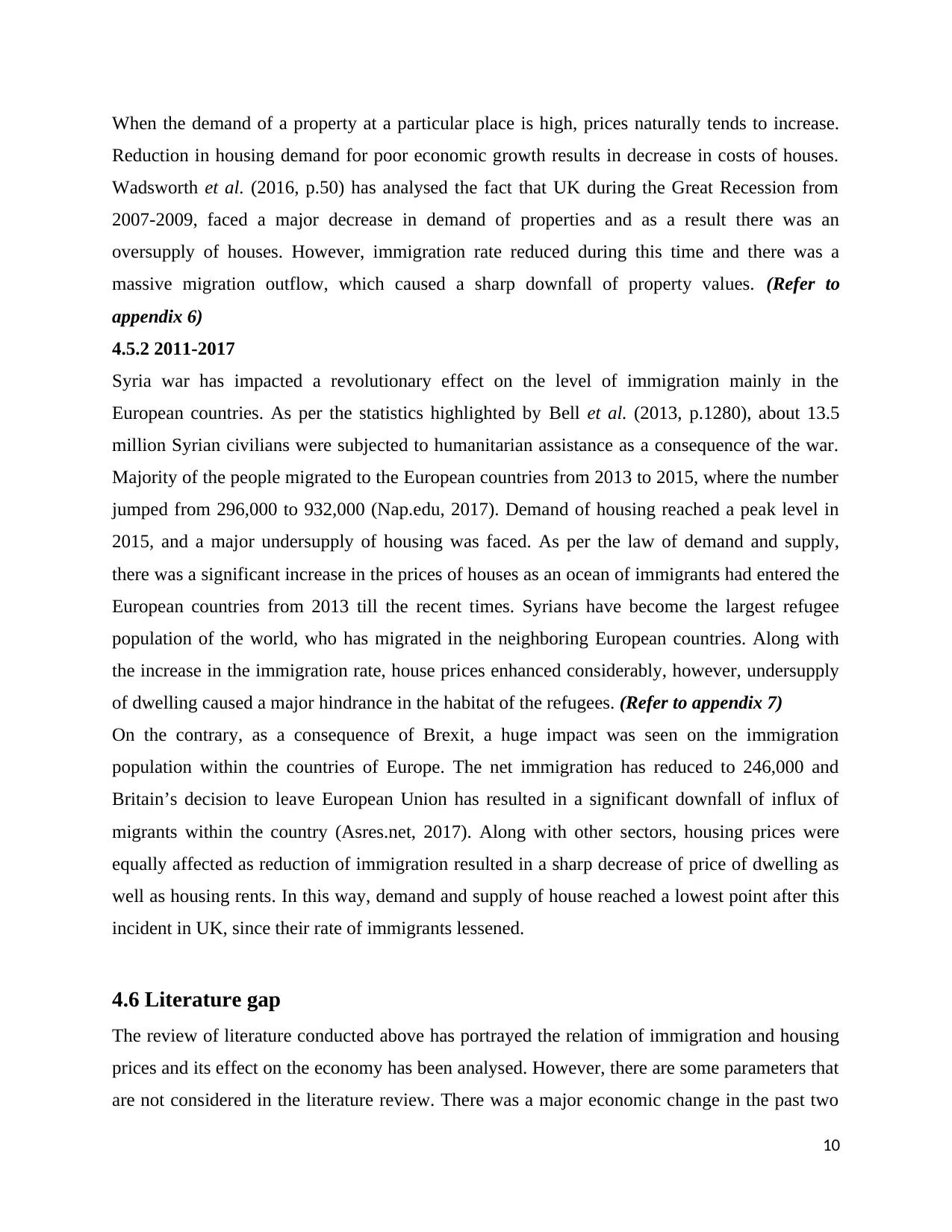
When the demand of a property at a particular place is high, prices naturally tends to increase.
Reduction in housing demand for poor economic growth results in decrease in costs of houses.
Wadsworth et al. (2016, p.50) has analysed the fact that UK during the Great Recession from
2007-2009, faced a major decrease in demand of properties and as a result there was an
oversupply of houses. However, immigration rate reduced during this time and there was a
massive migration outflow, which caused a sharp downfall of property values. (Refer to
appendix 6)
4.5.2 2011-2017
Syria war has impacted a revolutionary effect on the level of immigration mainly in the
European countries. As per the statistics highlighted by Bell et al. (2013, p.1280), about 13.5
million Syrian civilians were subjected to humanitarian assistance as a consequence of the war.
Majority of the people migrated to the European countries from 2013 to 2015, where the number
jumped from 296,000 to 932,000 (Nap.edu, 2017). Demand of housing reached a peak level in
2015, and a major undersupply of housing was faced. As per the law of demand and supply,
there was a significant increase in the prices of houses as an ocean of immigrants had entered the
European countries from 2013 till the recent times. Syrians have become the largest refugee
population of the world, who has migrated in the neighboring European countries. Along with
the increase in the immigration rate, house prices enhanced considerably, however, undersupply
of dwelling caused a major hindrance in the habitat of the refugees. (Refer to appendix 7)
On the contrary, as a consequence of Brexit, a huge impact was seen on the immigration
population within the countries of Europe. The net immigration has reduced to 246,000 and
Britain’s decision to leave European Union has resulted in a significant downfall of influx of
migrants within the country (Asres.net, 2017). Along with other sectors, housing prices were
equally affected as reduction of immigration resulted in a sharp decrease of price of dwelling as
well as housing rents. In this way, demand and supply of house reached a lowest point after this
incident in UK, since their rate of immigrants lessened.
4.6 Literature gap
The review of literature conducted above has portrayed the relation of immigration and housing
prices and its effect on the economy has been analysed. However, there are some parameters that
are not considered in the literature review. There was a major economic change in the past two
10
Reduction in housing demand for poor economic growth results in decrease in costs of houses.
Wadsworth et al. (2016, p.50) has analysed the fact that UK during the Great Recession from
2007-2009, faced a major decrease in demand of properties and as a result there was an
oversupply of houses. However, immigration rate reduced during this time and there was a
massive migration outflow, which caused a sharp downfall of property values. (Refer to
appendix 6)
4.5.2 2011-2017
Syria war has impacted a revolutionary effect on the level of immigration mainly in the
European countries. As per the statistics highlighted by Bell et al. (2013, p.1280), about 13.5
million Syrian civilians were subjected to humanitarian assistance as a consequence of the war.
Majority of the people migrated to the European countries from 2013 to 2015, where the number
jumped from 296,000 to 932,000 (Nap.edu, 2017). Demand of housing reached a peak level in
2015, and a major undersupply of housing was faced. As per the law of demand and supply,
there was a significant increase in the prices of houses as an ocean of immigrants had entered the
European countries from 2013 till the recent times. Syrians have become the largest refugee
population of the world, who has migrated in the neighboring European countries. Along with
the increase in the immigration rate, house prices enhanced considerably, however, undersupply
of dwelling caused a major hindrance in the habitat of the refugees. (Refer to appendix 7)
On the contrary, as a consequence of Brexit, a huge impact was seen on the immigration
population within the countries of Europe. The net immigration has reduced to 246,000 and
Britain’s decision to leave European Union has resulted in a significant downfall of influx of
migrants within the country (Asres.net, 2017). Along with other sectors, housing prices were
equally affected as reduction of immigration resulted in a sharp decrease of price of dwelling as
well as housing rents. In this way, demand and supply of house reached a lowest point after this
incident in UK, since their rate of immigrants lessened.
4.6 Literature gap
The review of literature conducted above has portrayed the relation of immigration and housing
prices and its effect on the economy has been analysed. However, there are some parameters that
are not considered in the literature review. There was a major economic change in the past two
10
Paraphrase This Document
Need a fresh take? Get an instant paraphrase of this document with our AI Paraphraser
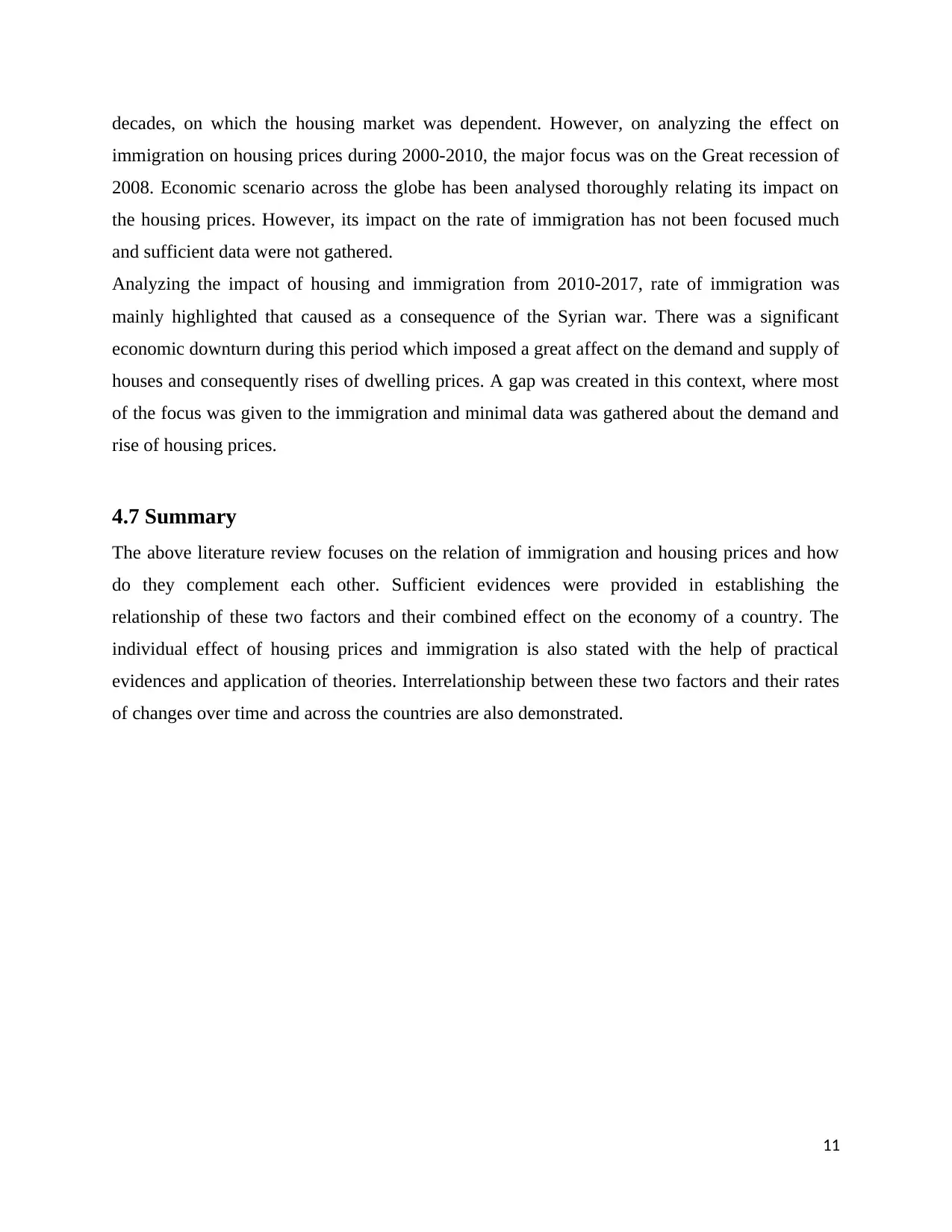
decades, on which the housing market was dependent. However, on analyzing the effect on
immigration on housing prices during 2000-2010, the major focus was on the Great recession of
2008. Economic scenario across the globe has been analysed thoroughly relating its impact on
the housing prices. However, its impact on the rate of immigration has not been focused much
and sufficient data were not gathered.
Analyzing the impact of housing and immigration from 2010-2017, rate of immigration was
mainly highlighted that caused as a consequence of the Syrian war. There was a significant
economic downturn during this period which imposed a great affect on the demand and supply of
houses and consequently rises of dwelling prices. A gap was created in this context, where most
of the focus was given to the immigration and minimal data was gathered about the demand and
rise of housing prices.
4.7 Summary
The above literature review focuses on the relation of immigration and housing prices and how
do they complement each other. Sufficient evidences were provided in establishing the
relationship of these two factors and their combined effect on the economy of a country. The
individual effect of housing prices and immigration is also stated with the help of practical
evidences and application of theories. Interrelationship between these two factors and their rates
of changes over time and across the countries are also demonstrated.
11
immigration on housing prices during 2000-2010, the major focus was on the Great recession of
2008. Economic scenario across the globe has been analysed thoroughly relating its impact on
the housing prices. However, its impact on the rate of immigration has not been focused much
and sufficient data were not gathered.
Analyzing the impact of housing and immigration from 2010-2017, rate of immigration was
mainly highlighted that caused as a consequence of the Syrian war. There was a significant
economic downturn during this period which imposed a great affect on the demand and supply of
houses and consequently rises of dwelling prices. A gap was created in this context, where most
of the focus was given to the immigration and minimal data was gathered about the demand and
rise of housing prices.
4.7 Summary
The above literature review focuses on the relation of immigration and housing prices and how
do they complement each other. Sufficient evidences were provided in establishing the
relationship of these two factors and their combined effect on the economy of a country. The
individual effect of housing prices and immigration is also stated with the help of practical
evidences and application of theories. Interrelationship between these two factors and their rates
of changes over time and across the countries are also demonstrated.
11
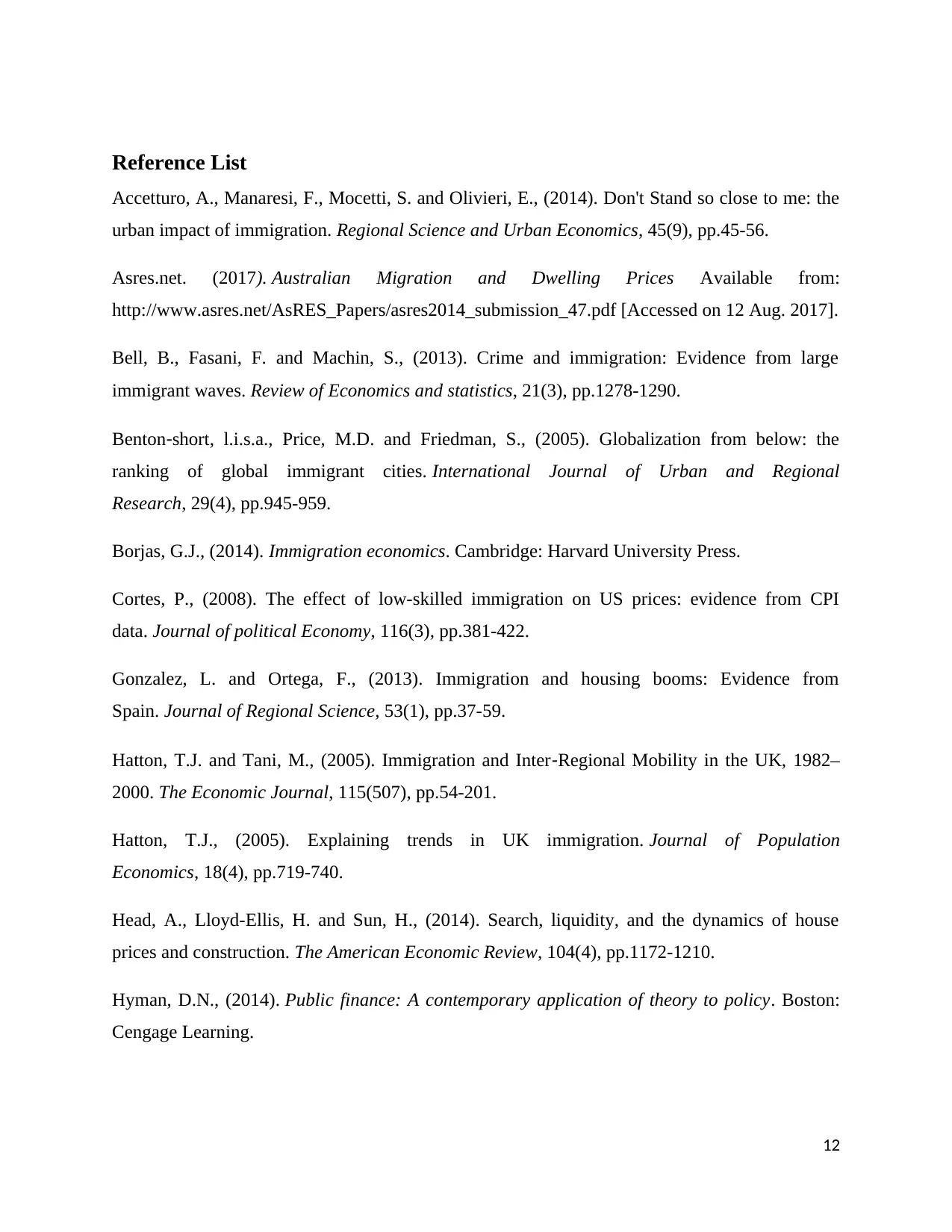
Reference List
Accetturo, A., Manaresi, F., Mocetti, S. and Olivieri, E., (2014). Don't Stand so close to me: the
urban impact of immigration. Regional Science and Urban Economics, 45(9), pp.45-56.
Asres.net. (2017). Australian Migration and Dwelling Prices Available from:
http://www.asres.net/AsRES_Papers/asres2014_submission_47.pdf [Accessed on 12 Aug. 2017].
Bell, B., Fasani, F. and Machin, S., (2013). Crime and immigration: Evidence from large
immigrant waves. Review of Economics and statistics, 21(3), pp.1278-1290.
Benton‐short, l.i.s.a., Price, M.D. and Friedman, S., (2005). Globalization from below: the
ranking of global immigrant cities. International Journal of Urban and Regional
Research, 29(4), pp.945-959.
Borjas, G.J., (2014). Immigration economics. Cambridge: Harvard University Press.
Cortes, P., (2008). The effect of low-skilled immigration on US prices: evidence from CPI
data. Journal of political Economy, 116(3), pp.381-422.
Gonzalez, L. and Ortega, F., (2013). Immigration and housing booms: Evidence from
Spain. Journal of Regional Science, 53(1), pp.37-59.
Hatton, T.J. and Tani, M., (2005). Immigration and Inter‐Regional Mobility in the UK, 1982–
2000. The Economic Journal, 115(507), pp.54-201.
Hatton, T.J., (2005). Explaining trends in UK immigration. Journal of Population
Economics, 18(4), pp.719-740.
Head, A., Lloyd-Ellis, H. and Sun, H., (2014). Search, liquidity, and the dynamics of house
prices and construction. The American Economic Review, 104(4), pp.1172-1210.
Hyman, D.N., (2014). Public finance: A contemporary application of theory to policy. Boston:
Cengage Learning.
12
Accetturo, A., Manaresi, F., Mocetti, S. and Olivieri, E., (2014). Don't Stand so close to me: the
urban impact of immigration. Regional Science and Urban Economics, 45(9), pp.45-56.
Asres.net. (2017). Australian Migration and Dwelling Prices Available from:
http://www.asres.net/AsRES_Papers/asres2014_submission_47.pdf [Accessed on 12 Aug. 2017].
Bell, B., Fasani, F. and Machin, S., (2013). Crime and immigration: Evidence from large
immigrant waves. Review of Economics and statistics, 21(3), pp.1278-1290.
Benton‐short, l.i.s.a., Price, M.D. and Friedman, S., (2005). Globalization from below: the
ranking of global immigrant cities. International Journal of Urban and Regional
Research, 29(4), pp.945-959.
Borjas, G.J., (2014). Immigration economics. Cambridge: Harvard University Press.
Cortes, P., (2008). The effect of low-skilled immigration on US prices: evidence from CPI
data. Journal of political Economy, 116(3), pp.381-422.
Gonzalez, L. and Ortega, F., (2013). Immigration and housing booms: Evidence from
Spain. Journal of Regional Science, 53(1), pp.37-59.
Hatton, T.J. and Tani, M., (2005). Immigration and Inter‐Regional Mobility in the UK, 1982–
2000. The Economic Journal, 115(507), pp.54-201.
Hatton, T.J., (2005). Explaining trends in UK immigration. Journal of Population
Economics, 18(4), pp.719-740.
Head, A., Lloyd-Ellis, H. and Sun, H., (2014). Search, liquidity, and the dynamics of house
prices and construction. The American Economic Review, 104(4), pp.1172-1210.
Hyman, D.N., (2014). Public finance: A contemporary application of theory to policy. Boston:
Cengage Learning.
12
⊘ This is a preview!⊘
Do you want full access?
Subscribe today to unlock all pages.

Trusted by 1+ million students worldwide
1 out of 20
Related Documents
Your All-in-One AI-Powered Toolkit for Academic Success.
+13062052269
info@desklib.com
Available 24*7 on WhatsApp / Email
![[object Object]](/_next/static/media/star-bottom.7253800d.svg)
Unlock your academic potential
Copyright © 2020–2025 A2Z Services. All Rights Reserved. Developed and managed by ZUCOL.





